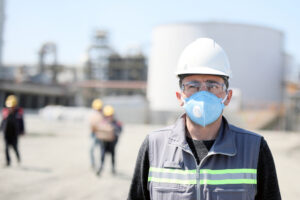How Dry Ice Blasting Is Revolutionizing Cleaning in Industry
Cleaning machines, equipment, and surfaces is a crucial task across many industries. Whether it’s in manufacturing plants, food processing facilities, automotive workshops, or historic restoration projects, keeping things clean is essential for safety, efficiency, and quality. Traditionally, cleaning has involved the use of water, chemicals, or abrasive materials such as sand, soda, or grit blasting. While these methods can be effective, they also come with several drawbacks. They can be slow, messy, and sometimes even harmful to the surfaces being cleaned. These methods often require extensive cleanup afterward and can result in damage or corrosion over time.
In recent years, a new cleaning technology called dry ice blasting has been changing the way industries clean their equipment and surfaces. This innovative method offers a faster, safer, and often more effective alternative to traditional cleaning techniques. Dry ice blasting is becoming a popular choice across industries due to its unique advantages and environmentally friendly nature.
What Is Dry Ice Blasting?
Dry ice blasting is a specialized cleaning process that uses solid carbon dioxide pellets, commonly known as dry ice pellets, to clean surfaces. These pellets are blasted at high speed using compressed air onto the surface that needs cleaning. Because dry ice pellets are extremely cold—at about -78.5°C (-109.3°F)—they help break down and lift away dirt, paint, grease, oil, and other unwanted contaminants effectively.
One of the most remarkable features of dry ice blasting is the way dry ice behaves during the cleaning process. When dry ice pellets come into contact with a surface, they do not melt into liquid as regular ice would. Instead, dry ice undergoes a process called sublimation, where it changes directly from a solid into carbon dioxide gas. This process means that dry ice blasting leaves no residue behind, eliminating the need to clean up secondary waste such as water, chemicals, or abrasive materials. This makes the process incredibly clean and efficient.
How Does Dry Ice Blasting Work?
The cleaning process with dry ice blasting is based on three key effects working together to remove contaminants:
Impact
The dry ice pellets are propelled at high speeds by compressed air and hit the surface with significant force. This impact helps to physically break loose dirt, grease, paint, or other coatings from the surface.
Cold Shock
Because the pellets are extremely cold, their contact with the surface causes a rapid temperature drop in the contaminants. This sudden cooling causes the dirt or paint to freeze and become brittle. Brittle materials crack and separate from the surface more easily, making it simpler to remove.
Sublimation
As soon as the dry ice pellets hit the surface, they start to sublimate—changing from solid to gas almost instantly. This expansion of carbon dioxide gas is very rapid and increases about 800 times in volume. The expanding gas helps to lift the loosened contaminants off the surface, further aiding in their removal.
Together, these three effects make dry ice blasting a powerful cleaning method that does not require water, chemicals, or abrasive media. This means the surfaces remain undamaged, and there is no leftover debris to clean.
Advantages of Dry Ice Blasting
Dry ice blasting offers several important benefits over traditional cleaning methods:
- Non-Abrasive Cleaning: Because dry ice pellets vaporize upon impact, the process does not wear down or scratch delicate surfaces. This makes it ideal for cleaning electronics, soft metals, painted surfaces, and historic artifacts that could be damaged by harsher methods.
- No Water or Chemicals Needed: Dry ice blasting eliminates the use of water or harsh cleaning chemicals. This prevents issues like water damage, corrosion, or chemical residues that could harm equipment or the environment.
- Environmentally Friendly: The carbon dioxide used in dry ice blasting is typically captured as a byproduct from other industrial processes, meaning it is recycled rather than newly produced. Moreover, no secondary waste such as sand or chemical runoff is created, making it a cleaner choice for the environment.
- Reduced Downtime: Dry ice blasting is typically faster than traditional cleaning methods, so machines and equipment spend less time out of operation. This can improve productivity and reduce maintenance costs.
- Versatile Applications: This cleaning method is effective on a wide range of materials and in various industries, including food processing, automotive repair, electronics manufacturing, and historic restoration.
Common Applications
Industries across the board have found practical uses for dry ice blasting:
- Food Processing: Cleaning food production equipment without water or chemicals reduces the risk of contamination and helps comply with strict health standards.
- Automotive Industry: Removing grease, oil, paint, and grime from engines and parts without damaging sensitive components improves repair and manufacturing processes.
- Electronics Manufacturing: Cleaning circuit boards and other delicate components safely without moisture helps maintain quality and reliability.
- Historic Restoration: Safely removing layers of dirt, old paint, or corrosion from fragile buildings and artifacts preserves their value and integrity.
- Manufacturing and Industrial Maintenance: Keeping molds, tools, and machinery clean increases product quality and extends equipment life.
Safety Considerations
While dry ice blasting is generally safe when used correctly, there are important safety measures to keep in mind. Operators must wear protective gloves and goggles because the extreme cold of dry ice can cause frostbite or eye injuries. Additionally, since dry ice turns into carbon dioxide gas, proper ventilation is essential to prevent dangerous gas buildup in enclosed areas. Training and adherence to safety guidelines ensure that dry ice blasting can be performed safely and effectively.
Conclusion
Dry ice blasting is revolutionizing the cleaning industry by offering a faster, safer, and more environmentally responsible alternative to traditional cleaning methods. Its ability to clean thoroughly without damaging surfaces or creating secondary waste makes it a preferred choice across many industries. From food processing to automotive repair and historic restoration, dry ice blasting provides a modern solution that meets the increasing demand for efficient and sustainable cleaning.
If your business is still relying on water, chemicals, or abrasive blasting, it might be time to explore the many benefits of dry ice blasting. This innovative technology could be the answer to cleaner equipment, less downtime, and a greener operation.



